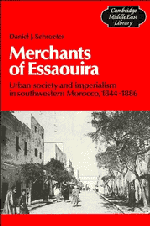Book contents
- Frontmatter
- Contents
- List of illustrations
- Map 1 General map of Morocco
- Preface
- Notes on usage
- Abbreviations
- Chronology
- 1 Introduction
- 2 The royal port
- 3 Merchants of the Sultan
- 4 Port and bazaar
- 5 Beyond the walls
- 6 The politics of trade
- 7 Foreign intervention and domestic reforms
- 8 The struggle for the southwest
- 9 The people of Essaouira in precolonial times
- 10 The end of an era
- Appendix A Corcos collection: nineteenth-century Arabic documents (1843–83)
- Appendix B Population estimates of Essaouira
- Appendix C Balancing revenue and expenditure: accounts of the port
- Appendix D Trade statistics for Essaouira
- Notes
- Bibliography
- Index
5 - Beyond the walls
Published online by Cambridge University Press: 04 August 2010
- Frontmatter
- Contents
- List of illustrations
- Map 1 General map of Morocco
- Preface
- Notes on usage
- Abbreviations
- Chronology
- 1 Introduction
- 2 The royal port
- 3 Merchants of the Sultan
- 4 Port and bazaar
- 5 Beyond the walls
- 6 The politics of trade
- 7 Foreign intervention and domestic reforms
- 8 The struggle for the southwest
- 9 The people of Essaouira in precolonial times
- 10 The end of an era
- Appendix A Corcos collection: nineteenth-century Arabic documents (1843–83)
- Appendix B Population estimates of Essaouira
- Appendix C Balancing revenue and expenditure: accounts of the port
- Appendix D Trade statistics for Essaouira
- Notes
- Bibliography
- Index
Summary
The approach to Essaouira from the land presents the image of an oasis. ‘It bursts upon one's view like a desert mirage, for several miles of drifting sand-hills have first to be crossed and on the far side nestles the town, its white roofs and mosque towers shown up clearly by the deep blue sea beyond.’ Essaouira appears like most other cities in Morocco: its immediate hinterland is uncultivated. Only a few gardens stretch out for a short distance beyond the ramparts. The town itself is on a promontory jetting out into the sea, so that its climate is always temperate and breezy. One has to travel only a few miles inland to enter a hot, intemperate zone. The city, surrounded by its walls, gives one a sense of isolation from the rest of the world; its micro-climate contributes to this feeling of detachment from the rest of Morocco.
And yet this physical image belies the senses. In many ways Essaouira was tied both to its hinterland and to distant inland markets. The constant stream of merchants and pedlars – of Berber tribesmen and Jews – through the town gates was another striking image of the town. This continual movement of people and goods relied on social networks which, under normal conditions, facilitated the peaceful passage of itinerant traders and caravans over distances near and far.
- Type
- Chapter
- Information
- Merchants of EssaouiraUrban Society and Imperialism in Southwestern Morocco, 1844–1886, pp. 85 - 116Publisher: Cambridge University PressPrint publication year: 1988

